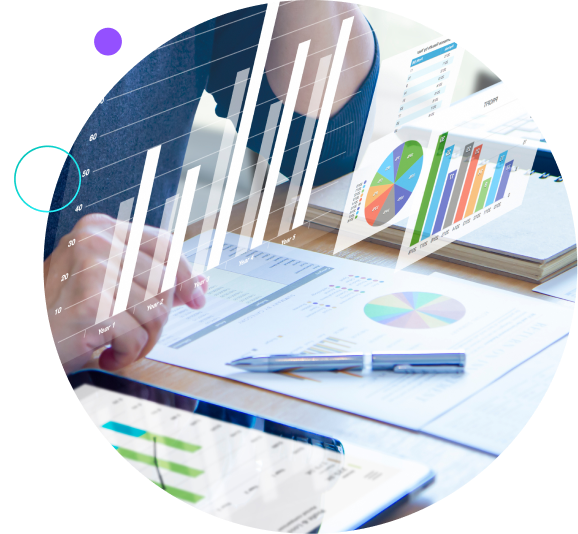You might think that “data” and “storytelling” are two words you don’t often see together. But if you’re only using your brand’s data for reports and spreadsheets, then you’re missing out.
It’s no secret that people love stories, and numbers have an important story to tell. In this article, we’ll dive into what data-driven brand storytelling is, what makes it so powerful, and how you can use it to drive brand awareness.
What is Data-Driven Brand Storytelling?
Data-driven brand storytelling is when a company uses its own data, such as from research or studies, to share information about its brand, products, or the industry it’s in — all in a creative and compelling way.
It involves turning large, complex data sets into insightful stories that are easy to visualize, understand, and remember.
Stories are more tangible than rows of data, which is why storytelling is such a powerful technique because it helps people understand the meaning behind the numbers. This is particularly important — as data is useless if no one understands it well enough to act on its insights.
Data-driven brand storytelling can take many forms — it might be an infographic, a video, a series of social media posts, or even a billboard. The idea is to convey the data in an engaging and visual way in order to provide value to new and existing customers.
How Can Data-Driven Storytelling Help Your Brand?
Telling stories with data is a great way for brands to connect with consumers and win over new customers. What makes it so effective? Well, for starters, data-driven storytelling uses visual imagery, which our brains love.
Our brains process images 60,000 times faster than words, 90% of information transmitted to the brain is visual, and we are 65% more likely to retain information if it includes an image.
This is what makes data visualization methods — like infographics, charts, and images — so useful.
Marketers and journalists often use data in a visual format to tell new stories or convey a concept from a different perspective. They know that we are wired to prefer visual stories over statistics.
Take the example from Tower Electric Bikes, a direct to consumer eBike brand, seen above.
They gave each city in the US a bike-friendliness rating and depicted the results on a handy map. Instead of having to read a long report about how different cities treat cyclists, the reader sees at a glance which cities are bike-friendly.
This enables the brand to showcase its expertise in the cycling space while providing value to its target audience — cycling enthusiasts — in a unique and compelling way.
The Benefits of Data-Driven Brand Storytelling
There are many reasons why data-driven storytelling is useful for brands:
Meaning & Context: Stories put the data into context so that the audience understands the meaning behind the numbers.
Trust: Numbers and statistics increase the credibility of your content and reinforce your brand’s status as a trustworthy and reliable source of information.
Attention: A beautifully-designed infographic or engaging video, with data to back it up, stands out and is highly shareable — thus exposing your brand to new audiences.
Versatility: You can play with various content formats and leverage different channels, whether you need case studies for your website, videos on your YouTube channel, or graphics for your social media.
How and When to Use Data-Driven Brand Storytelling
There are many use cases for data-driven storytelling. Let’s explore a few ways your brand can use data to tell a story:
1. Trends
Data-driven storytelling is useful for showing how trends change over time.
For example, if you are a coffee brand, you could show how coffee consumption has increased or changed over time, which countries consume the most coffee, and what kinds of coffee different generations prefer.
2. Comparisons
Comparisons are interesting. Getting back to our coffee example, you could show how much coffee Millennials consume compared to Gen Z.
Surprising or unexpected information that challenges our beliefs and expectations is particularly engaging.
3. Relationships
Correlation and causation are complex, but sharing the data in a creative way with a storytelling approach makes it easier to understand.
For example, you could show the correlation between career paths and coffee consumption to show the impact people’s jobs have on their caffeine habits.
5 Tips to Ace Data-Driven Storytelling
As a brand analytics company, we at Latana deal with a lot of data and are always coming up with new, engaging ways to present it.
Let’s take a look at our top tips for telling a compelling story with data.
1. Less is more
When analyzing large, complex data sets, it’s easy to become overwhelmed. Don’t get overloaded by too much data and fall into the trap of trying to share all the information. Instead, look for overall patterns and try to spot the biggest trends — as this is what is going to be most relevant and interesting for your target audience.
Google does a great job of this. Google Maps has a lot of data on its users, but it shares only the most interesting insights in the Google Maps newsletter. Google understands its customers are mainly interested in the new places they have visited and how active they have been that month — therefore, it doesn’t bother with all the specifics.
2. Context is your friend
When you use data to tell a story, it’s important to frame that information within its broader context. Numbers alone can be difficult to understand and interpret. You need to put the data into perspective, so your audience understands the bigger picture.
Uber does a great job of this. Instead of simply saying, “You have driven 406 miles with Uber” they put the number into context by comparing it with Olympic swimming pools. This kind of comparison makes the number more “real” and easier to understand.
3. A picture is worth a thousand words
Accurate data and interesting insights are important, but that’s not enough. The content needs to be visually appealing to stand out and drive brand performance.
A stunning infographic or beautifully-illustrated social media banners can take the data and insights to the next level. On the other hand, too much text, hard-to-read text, or unappealing colors will have a negative impact.
It’s worth collaborating with a professional designer, as they will know how to harness the right visual elements to strengthen your overall message and narrative. Don’t underestimate the importance of telling your story visually — this part can make or break your storytelling strategy.
4. Be creative
Can you put an interesting or unique spin on your insights? Perhaps you can inject a dash of humor? Spotify is best-in-class at using data in a humorous way to drive brand awareness. They are well-known for their billboard campaigns fueled by data, seen below.
5. Start storyboarding
The storyboarding process is a great way to craft a compelling story. It helps you to extract the key data points, identify the main messages, and put them in order to tell your story.
This approach enables you to transform abstract ideas and unconnected data points into actual content your audience will love.
Follow these four steps to create a storyboard:
1. Prepare your outline Gather the information, then extract the key points. What are the key messages you want to share with your target audience?
3. Start sketching Sketch the key messages into the squares of your storyboard.
5. Put the story in order Think about how the story will unfold and if there are any missing points or anything you should cut out.
7. Brainstorm visualizations The final step is to consider the best ways to visualize your data – that might be a graph, images, or a combination of both.
The most important part of the storyboarding process is finding the key data points and messages. After that, and with the help of a good designer, you will be well on your way to telling a compelling story with your data.
Final Thoughts
Our brains are wired to love stories. Storytelling dates back to cave paintings from 1700 BCE, and our cultures and societies have always used stories to share useful information.
Brands like Uber and Spotify use data to connect with customers and provide unique insights and experiences. They know that facts present data, whereas a story provides context — which aids our understanding and encourages us to take action on the insights.
Content may be king, but it is getting harder and harder to stand out and capture your audience’s attention. Using data to tell unique and compelling stories is a powerful way for your brand to drive awareness and engagement.
Combining creativity and data can take your marketing to the next level and boost your brand. And if you want access to top-notch consumer data, look no further than brand monitoring software. Reliable, nuanced, and insightful, brand tracking data will help your brand excel at data-driven storytelling in 2022.







